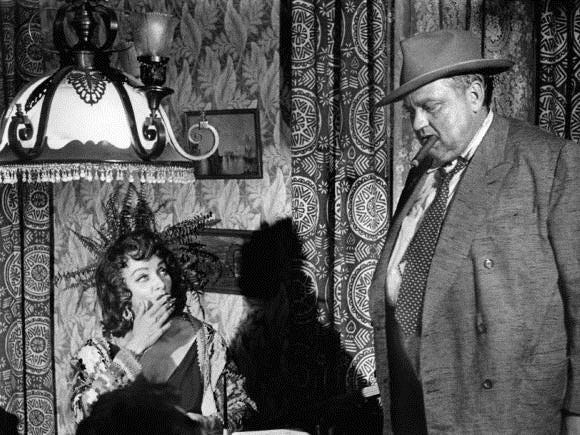Touch of Evil

When people ask my favorite Orson Welles picture, I give them a complicated answer. I respect “Citizen Kane” as one of the greatest (and perhaps most important) triumphs in the history of cinema. It’s at or near the top of any critic’s picks for the best pictures ever made. But my favorite? The one I’d prefer to sit down and watch on a cold winter afternoon? That’s “Touch of Evil” – the 1958 mystery / thriller that served as one of the last true examples of the original black-and-white film noir era (roughly the 1940s and ‘50s).
Following a decade of self-imposed exile in Europe, Welles returned to Hollywood in 1958, and Universal Studios promptly presented him with a stack of scripts. Always the narcissist, Welles told Universal he could make a classic out of the worst script in the pile. A day later, he began rewriting and casting “Touch of Evil,” based on Whit Masterson’s pulp fiction novel “Badge of Evil.”
By 1958, many actors considered it such an honor to work for Welles that they eagerly chose to accept pay scales far below their typical wages. Hence, Welles was blessed with the talents of two of the biggest stars of the era – Charlton Heston and Janet Leigh. Many other popular (and future) stars appear in “Touch of Evil” – including Marlene Dietrich and Zsa Zsa Gabor as employees of a local brothel, and a young Dennis Weaver as an unforgettably nervous hotel clerk.
Heston plays a Mexican drug enforcement official named Miguel Vargas, and Leigh is his newlywed American wife, Susie. Now, I know what you’re thinking – Charlton Heston plays a Mexican? Granted, Heston doesn’t look or sound any more like a Mexican than he does Moses. But Cecil B. DeMille cast him in that iconic role for “The Ten Commandments,” so it’s not too big a stretch to see him as a Mexican. Plus, casting directors were intent on hooking the biggest stars back in the Hollywood studio era, rather than using actors who actually looked the part.
So just go with me here. Heston’s investigating drug crimes in a border town, when he witnesses a Mexican car bomb cross the border in the trunk of a car, which subsequently bursts into flames. Suspecting a drug crime, Vargas meets the local American law enforcement officials on the scene, and shares information. Welles himself plays corrupt Captain Hank Quinlan, who immediately suspects Sanchez – a Mexican secretly married to the victim’s daughter. During the investigation, Vargas accuses Quinlan of planting evidence, and then suspects this to be a pattern. Quinlan then has a confidant attack Susie Vargas at an isolated motel, and the plot begins to thicken. “Touch of Evil” is chock full of double-crosses, but it’s never difficult to follow.
And the acting is first-rate. After all, has anybody ever played the damsel in distress better than Leigh? But the one who really shines here is Welles himself. Often shot from the ground looking up to make him appear larger, Welles’ Quinlan is evil personified. Half the joy of watching “Touch of Evil” is to see how far Quinlan will go to preserve his position and his reputation. You’ve heard it said that the best movies are those with the best villains? Exhibit A is Orson Welles in “Touch of Evil.”
While “Touch of Evil” is certainly not a comedy, it is an absolute joy to watch in the same way we delight in some of the Coen Brothers' best material. Remember the Oscar-winning “No Country for Old Men?” We had no idea where it was going, but the tight script and quirky characters corralled our interest practically from the opening frame. (And it, too, featured one of the creepiest villains in modern cinema.) The same is true here. In fact, movie buffs know “Touch of Evil” for its classic 3½-minute opening tracking shot – the longest in film history until Robert Altman’s “The Player” topped it by a few seconds (in a tribute to Welles).
Every plot twist forces us to see one or more characters in a new light. Perhaps only Welles could have taken a throwaway novel and produced one of the greats of the film noir era. But as with most of his work, the studio saw fit to tamper with the final product by cutting a few vital scenes so that it could be shown as part of a double-feature. Universal also plastered large opening credits over the first part of that epochal tracking shot.
Fortunately, in 1998 film editor Walter Murch (along with Universal’s director of film restoration) reconstructed “Touch of Evil” to what is believed to be Welles’ original intent, based on a lengthy letter he had written to the studio complaining about their edits. That version was re-released to the public, and is now preserved in the American Film Registry by the Library of Congress. It is the only version you’ll encounter when you seek it out. The edited Universal version released in 1958 has long since been destroyed.
“Touch of Evil” is scandalous fun and an outright pleasure to watch. And that’s why it’s this month’s Buried Treasure.
Andy Ray's reviews of current films appear on http://www.artschannelindy.com/



